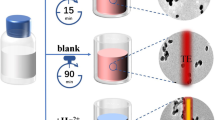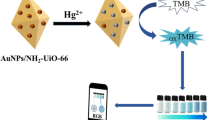Abstract
This work describes two new colorimetric methods for smartphone-based point-of-care nanosensing of toxic Ag+ ions. They were based on the analyte-triggered in situ “off–on” of Tyndall effect (TE) of non-plasmonic colloid or plasmonic metal nanoprobes. The first TE-inspired assay (TEA) focused on the initial analytical application of precipitation reactions where a non-plasmonic AgCl colloid could be formed once mixing the analyte with a NaCl solution. Such AgCl colloid displayed strong visual TE signals after their irradiation by a laser pointer pen, which unexpectedly achieved a detection limit of ~ 400 nM. The second TEA was further designed to reduce the limit down to ~ 78 nM using the analyte’s oxidizability towards 3,3′,5,5′-tetramethylbenzidine molecules. The redox reaction could create positively charged products that could make negatively charged plasmonic gold nanoparticles aggregate through electrostatic interactions to remarkably amplify their TE responses. Both limits were lower than the minimum allowable Ag+ level (~ 460 nM) in drinking water issued by the World Health Organization. The satisfactory recovery results for detecting Ag+ ions in river, pond, tap, and drinking water additionally demonstrated good selectivity, accuracy and practicality of the proposed methods for potential point-of-need uses in environmental analysis, public health, water safety, etc.
Graphical abstract






Similar content being viewed by others
References
Yang, J. H., Zhang, Y., Zhang, L., Wang, H. L., Nie, J. F., Qin, Z. X., Li, J., & Xiao, W. C. (2017). Analyte-triggered autocatalytic amplification combined with gold nanoparticle probes for colorimetric detection of heavy-metal ions. Chemical Communications, 53, 7477–7480. https://doi.org/10.1039/C7CC02198D
Bilgic, A. (2022). Fabrication of monoBODIPY-functionalized Fe3O4@SiO2@TiO2 nanoparticles for the photocatalytic degradation of rhodamine B under UV irradiation and the detection and removal of Cu(II) ions in aqueous solutions. Journal of Alloys and Compounds, 899, 163360. https://doi.org/10.1016/j.jallcom.2021.163360
Bilgic, A., Cimen, A., & Kursunlu, A. N. (2022). “Killing two birds with one stone”: A fluorescent hybrid nanoparticle modified with BODIPY for efficiently detection and removal of toxic Cu(II) ion from aqueous solutions. Science of the Total Environment, 845, 157170. https://doi.org/10.1016/j.scitotenv.2022.157170
Ratte, H. T. (1999). Bioaccumulation and toxicity of silver compounds: A review. Environmental Toxicology and Chemistry, 18, 89–108. https://doi.org/10.1002/etc.5620180112
Kursunlu, A. N., Oguz, M., & Yilmaz, M. (2018). On/off rhodamine-BODIPY-based fluorimetric/colorimetric sensor for detection of mercury(II) in half-aqueous medium. IEEE Sensors Journal, 19, 2009–2015. https://doi.org/10.1109/JSEN.2018.2886383
Alizadeh, A., Abdi, G., & Khodaei, M. M. (2016). Colorimetric and visual detection of silver(I) using gold nanoparticles modified with furfuryl alcohol. Microchimica Acta, 183, 1995–2003. https://doi.org/10.1007/s00604-016-1830-7
Kim, S., Choi, J. E., Choi, J., Chung, K. H., Park, K., Yi, J., & Ryu, D. Y. (2009). Oxidative stress-dependent toxicity of silver nanoparticles in human hepatoma cells. Toxicology in Vitro, 23, 1076–1084. https://doi.org/10.1016/j.tiv.2009.06.001
Drake, P. L., & Hazelwood, K. J. (2005). Exposure-related health effects of silver and silver compounds: A review. Annals of Occupational Hygiene, 49, 575–585. https://doi.org/10.1093/annhyg/mei019
Hadrup, N., & Lam, H. R. (2014). Oral toxicity of silver ions, silver nanoparticles and colloidal silver—A review. Regulatory Toxicology and Pharmacology, 68, 1–7. https://doi.org/10.1016/j.yrtph.2013.11.002
Li, J. J., Xi, H. Y., Kong, C. Y., Liu, Q. Y., & Chen, Z. B. (2018). “Aggregation-to-deaggregation” colorimetric signal amplification strategy for Ag+ detection at the femtomolar level with dark-field microscope observation. Analytical Chemistry, 90, 11723–11727. https://doi.org/10.1021/acs.analchem.8b03739
Dadfarnia, S., Haji Shabani, A. M., & Gohari, M. (2004). Trace enrichment and determination of silver by immobilized DDTC microcolumn and flow injection atomic absorption spectrometry. Talanta, 64, 682–687. https://doi.org/10.1016/j.talanta.2004.03.039
Shervedani, R. K., & Babadi, M. K. (2006). Application of 2-mercaptobenzothiazole self-assembled monolayer on polycrystalline gold electrode as a nanosensor for determination of Ag(I). Talanta, 69, 741–746. https://doi.org/10.1016/j.talanta.2005.11.009
Krachler, M., Mohl, C., Emons, H., & Shotyk, W. (2002). Analytical procedures for the determination of selected trace elements in peat and plant samples by inductively coupled plasma mass spectrometry. Spectrochim Acta B, 57, 1277–1289. https://doi.org/10.1016/S0584-8547(02)00068-X
Hosoba, M., Oshita, K., Katarina, R. K., Takayanagi, T., Oshima, M., & Motomizu, S. (2009). Synthesis of novel chitosan resin possessing histidine moiety and its application to the determination of trace silver by ICP-AES coupled with triplet automated-pretreatment system. Analytica Chimica Acta, 639, 51–56. https://doi.org/10.1016/j.aca.2009.02.050
Zhang, X. B., Han, Z. X., Fang, Z. H., Shen, G. L., & Yu, R. Q. (2006). 5,10,15-Tris(pentafluorophenyl)corrole as highly selective neutral carrier for a silver ion-sensitive electrode. Analytica Chimica Acta, 562, 210–215. https://doi.org/10.1016/j.aca.2006.01.056
Tang, S., Chen, D., Guo, G., Li, X., Wang, C., Li, T., & Wang, G. (2022). A smartphone-integrated optical sensing platform based on Lycium ruthenicum derived carbon dots for real-time detection of Ag(I). Science of the Total Environment, 825, 153913. https://doi.org/10.1016/j.scitotenv.2022.153913
Wu, Y., Jiang, T. T., Wu, Z. Y., & Yu, R. Q. (2018). Internal standard-based SERS aptasensor for ultrasensitive quantitative detection of Ag+ ion. Talanta, 185, 30–36. https://doi.org/10.1016/j.talanta.2018.03.014
Jayeoye, T. J., Ma, J., & Rujiralai, T. (2021). Creatinine assembled on dithiobis(succinimidylpropionate) modified gold nanoparticles as a sensitive and selective colorimetric nanoprobe for silver ion detection. Journal of Environmental Chemical Engineering, 9, 105770. https://doi.org/10.1016/j.jece.2021.105770
Ding, Q., Li, C., Wang, H. J., Xu, C. L., & Kuang, H. (2021). Electrochemical detection of heavy metal ions in water. Chemical Communications, 57, 7215–7231. https://doi.org/10.1039/D1CC00983D
Priyadarshini, E., & Pradhan, N. (2017). Gold nanoparticles as efficient sensors in colorimetric detection of toxic metal ions: A review. Sensors and Actuators, B: Chemical, 238, 888–902. https://doi.org/10.1016/j.snb.2016.06.081
Zhang, Y., Bian, J., Li, Y., Lin, T., Zhang, J., Huo, K., Liu, X., Liu, Y., & Liu, Y. (2022). Gel-sol and colorimetric dual-modal sensor for highly selective and sensitive detection of iodide ions based on gelatin fabricated AuNPs. Sensors and Actuators, B: Chemical, 364, 131913. https://doi.org/10.1016/j.snb.2022.131913
Liu, Y., Cao, Y., Zhang, C., Ye, C., Bian, Q., Cheng, X., Xia, H., Zheng, J., & Liu, H. (2022). A novel colorimetric method for H2O2 sensing and its application: Fe(2+)-catalyzed H2O2 prevents aggregation of AuNPs by oxidizing cysteine (FeHOAuC). Analytica Chimica Acta, 1207, 339840. https://doi.org/10.1016/j.aca.2022.339840
Pan, Y., Wei, X. L., Guo, X. D., Wang, H., Song, H. Y., Pan, C. P., & Xu, N. F. (2021). Immunoassay based on Au–Ag bimetallic nanoclusters for colorimetric/fluorescent double biosensing of dicofol. Biosensors & Bioelectronics, 194, 113611. https://doi.org/10.1016/j.bios.2021.113611
Zhuang, X., Hu, Y., Wang, J., Hu, J., Wang, Q., & Yu, X. (2021). A colorimetric and SERS dual-readout sensor for sensitive detection of tyrosinase activity based on 4-mercaptophenyl boronic acid modified AuNPs. Analytica Chimica Acta, 1188, 339172. https://doi.org/10.1016/j.aca.2021.339172
Zhang, W. S., Pan, J. B., Li, F., Zhu, M., Xu, M. T., Zhu, H. Y., Yu, Y. Y., & Su, G. X. (2021). Reverse transcription recombinase polymerase amplification coupled with CRISPR-Cas12a for facile and highly sensitive colorimetric SARS-CoV-2 detection. Analytical Chemistry, 93, 4126–4133. https://doi.org/10.1021/acs.analchem.1c00013
Chen, X., Sun, Y., Mo, X., Gao, Q., Deng, Y., Hu, M., Zou, J., Nie, J., & Zhang, Y. (2021). On-site, rapid and visual method for nanomolar Hg2+ detection based on the thymine–Hg2+–thymine triggered “double” aggregation of Au nanoparticles enhancing the Tyndall effect. RSC Advances, 11, 36859–36865. https://doi.org/10.1039/D1RA07211K
Huang, J. K., Mo, X. M., Fu, H. Y., Sun, Y., Gao, Q., Chen, X. J., Zou, J. M., Yuan, Y. L., Nie, J. F., & Zhang, Y. (2021). Tyndall-effect-enhanced supersensitive naked-eye determination of mercury(II) ions with silver nanoparticles. Sensors and Actuators, B: Chemical, 344, 130218. https://doi.org/10.1016/j.snb.2021.130218
Deng, Z., Jin, W., Yin, Q., Huang, J., Huang, Z., Fu, H., Yuan, Y., Zou, J., Nie, J., & Zhang, Y. (2021). Ultrasensitive visual detection of Hg2+ ions via the Tyndall effect of gold nanoparticles. Chemical Communications, 57, 2613–2616. https://doi.org/10.1039/D0CC08003A
Yuan, K., Sun, Y., Liang, F., Pan, F., Hu, M., Hua, F., Yuan, Y., Nie, J., & Zhang, Y. (2022). Tyndall-effect-based colorimetric assay with colloidal silver nanoparticles for quantitative point-of-care detection of creatinine using a laser pointer pen and a smartphone. RSC Advances, 12, 23379–23386. https://doi.org/10.1039/D2RA03598G
Sun, Y., Yuan, K., Mo, X., Chen, X., Deng, Y., Liu, C., Yuan, Y., Nie, J., & Zhang, Y. (2022). Tyndall-effect-inspired assay with gold nanoparticles for the colorimetric discrimination and quantification of mercury ions and glutathione. Talanta, 238, 122999. https://doi.org/10.1016/j.talanta.2021.122999
Gao, Q., Wan, J., Chen, X. J., Mo, X. M., Sun, Y., Zou, J. M., Nie, J. F., & Zhang, Y. (2021). A novel strategy for sensitive and rapid detection of ascorbic acid via the Tyndall effect of cobalt hydroxide nanoflakes. RSC Advances, 11, 39306–39310. https://doi.org/10.1039/D1RA07702C
Xiao, W. C., Deng, Z. H., Huang, J. K., Huang, Z. H., Zhuang, M. M., Yuan, Y. L., Nie, J. F., & Zhang, Y. (2019). Highly sensitive colorimetric detection of a variety of analytes via the Tyndall effect. Analytical Chemistry, 91, 15114–15122. https://doi.org/10.1021/acs.analchem.9b03824
Rootman, D. B., Lin, J. L., Goldberg, R. J. O. P., & Surgery, R. (2014). Does the Tyndall effect describe the blue hue periodically observed in subdermal hyaluronic acid gel placement? Ophthalmic Plastic & Reconstructive Surgery, 30, 524–527. https://doi.org/10.1097/IOP.0000000000000293
West, F. K., West, P. W., Ramakrishna, T. J. E. S., Technology. (1967). Stabilization and determination of traces of silver in waters. Environmental Science & Technology Letters, 1, 717–720. https://doi.org/10.1021/es60009a007
Ministry of Health of the People’s Republic of China. (2006). GB 5749-2006 Standards for Drinking Water Quality.
Christian, G. D. (1994). Analytical chemistry (5th ed.). Wiley.
Wang, H. L., Zhang, Y., Li, R. X., Nie, J. F., El-Sagheer, A. H., Brown, T., Liu, Z. Y., & Xiao, W. C. (2017). Instrument-free quantitative gold nanoparticle-based liquid-phase colorimetric assays for use in resource-poor environments. Chemical Communications, 53, 8407–8410. https://doi.org/10.1039/C7CC03240D
Sener, G., Uzun, L., & Denizli, A. (2014). Lysine-promoted colorimetric response of gold nanoparticles: a simple assay for ultrasensitive mercury(II) detection. Analytical Chemistry, 86, 514–520. https://doi.org/10.1021/ac403447a
Tao, Y. Z., Luo, F., Guo, L. H., Qiu, B., & Lin, Z. Y. (2020). Target-triggered aggregation of gold nanoparticles for photothermal quantitative detection of adenosine using a thermometer as readout. Analytica Chimica Acta, 1110, 151–157. https://doi.org/10.1016/j.aca.2020.03.023
Acknowledgements
This work was financially supported by National Natural Science Foundation of China (Nos. 21874032, 21765007 and 21765005), Guangxi Science Fund for Distinguished Young Scholars (No. 2018GXNSFFA281002), and Central Government-Guided Local Science and Technology Development Project (No. GuikeZY20198006).
Author information
Authors and Affiliations
Corresponding authors
Ethics declarations
Conflict of interest
On behalf of all authors, the corresponding author states that there is no conflict of interest.
Supplementary Information
Below is the link to the electronic supplementary material.
Rights and permissions
Springer Nature or its licensor (e.g. a society or other partner) holds exclusive rights to this article under a publishing agreement with the author(s) or other rightsholder(s); author self-archiving of the accepted manuscript version of this article is solely governed by the terms of such publishing agreement and applicable law.
About this article
Cite this article
Hu, M., Xiao, W., Chen, Y. et al. Analyte-triggered in situ “off–on” of Tyndall effect for smartphone-based quantitative nanosensing of Ag+ ions. Photochem Photobiol Sci 22, 631–640 (2023). https://doi.org/10.1007/s43630-022-00341-w
Received:
Accepted:
Published:
Issue Date:
DOI: https://doi.org/10.1007/s43630-022-00341-w




